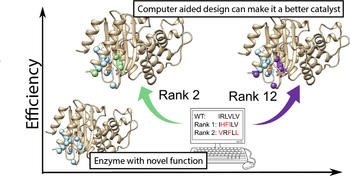This Blog Post is now in the queue for publishing as requested.
Depending on transfer load expect completion in around 15 minutes or 60 minutes if it has just been published by the owner.
This Blog Post has been removed from the queue for publishing as requested.
Ancient enzymes can contribute to greener chemistry
Posted by
Otto Knotzer on June 16, 2020 - 6:43am
Enzymes that are several billion years old are revived and a completely new, non-natural reaction is catalyzed.

Building on old protein structures, it is possible to create enzymes for new chemical reactions and to improve them with the help of bioinformatic calculations.
A research team at Uppsala University has resurrected enzymes that are several billion years old and reprogrammed them to catalyze completely different chemical reactions than their modern versions can. The method can be used to develop sustainable solutions within biotechnology, for example for enzyme bioreactors or for the chemical degradation of environmental toxins.
"We use software to simulate billions of years of evolution, and we've actually been able to develop an effective enzyme that can catalyze a whole new reaction. It's incredibly exciting," said Lynn Kamerlin, who heads the research team at Uppsala University.
Enzymes have the ability to catalyze chemical reactions from millions of years to fractions of a second, i.e. to accelerate without being consumed by yourself. They are also biodegradable and have a minimal carbon footprint. Most enzymes are catalysts for a specific chemical reaction that plays an important role in biological processes, for example in our body.
Biotechnology is working intensively on the development of new enzymes that can catalyze unusual reactions for green chemistry, sustainable catalysis and the chemical degradation of environmental toxins.
The research team at Uppsala University worked with colleagues at the Universidad de Granada in Spain to resurrect the ancestors' enzymes, first on the computer and then in the laboratory. The primitive enzymes have many properties that are desirable in biotechnology. They can withstand extreme temperatures and are structurally more flexible, making them easier to modify than their modern equivalents.
The researchers have succeeded in reusing old antibiotic-degrading enzymes to catalyze a completely new, non-natural reaction. But although the reused enzymes accelerated the reaction significantly, it was much slower than most naturally occurring enzymes.
To improve the efficiency of the enzyme, the researchers used powerful computers to calculate which changes in structure would lead to a faster response. They used a new method called FuncLib, which uses a combination of evolutionary information and protein stability calculations to predict more effective enzyme variants.
A total of 3,000 potential new enzyme variants have been predicted by FuncLib, and the 20 most promising have been tested in the laboratory. Four of these were much faster than the original enzyme. The best was as effective as the average modern, naturally occurring enzyme.
"Our study shows that it is possible to design new, effective enzymes for a more sustainable future,"


